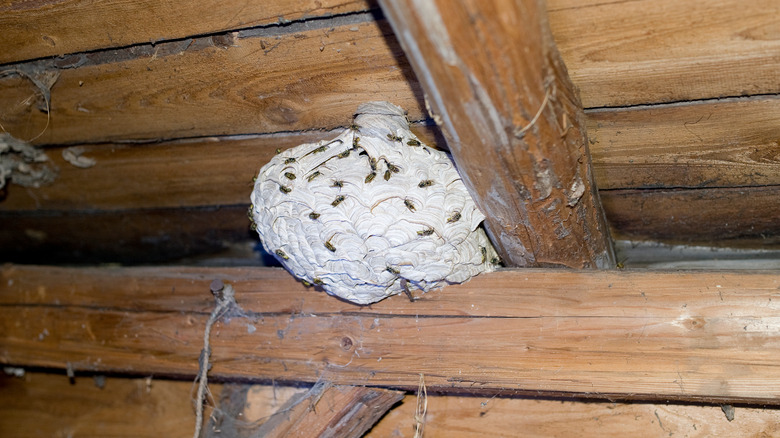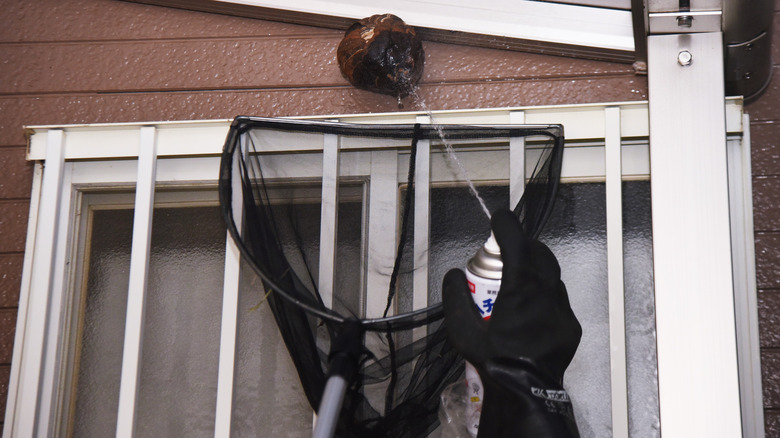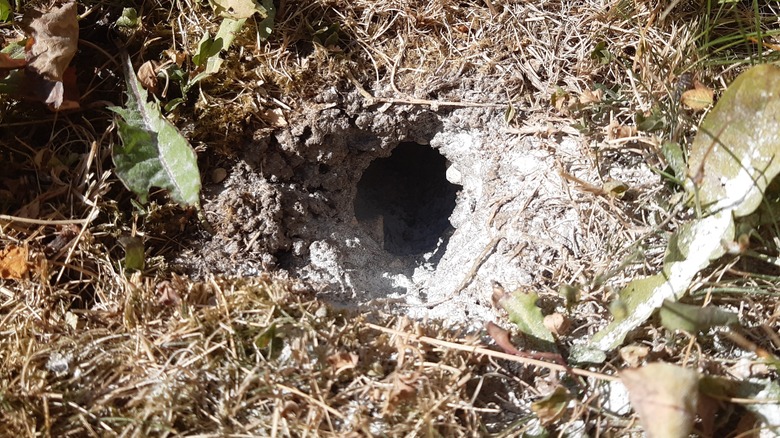How To Kill A Wasp Nest: Drenching Vs. Dusting, Explained
We may receive a commission on purchases made from links.
It's the stuff of horror flicks — buzzing, angry wasps have set up shop in a corner of your house or even garden. These winged menaces aren't just nuisances but downright dangerous, with the CDC estimating their yearly fatalities at 72 (including bees and hornets). Things that attract wasps to your home and garden range from fruit trees, human food, flowers, and open water to garbage. Now, they've overstayed their welcome in your home and must go. But then, how do you kill a wasp nest? Enter two options: drenching and dusting. Going the drenching route means gearing up with sprayers or extended nozzle contraptions, ready to unleash a deluge that'll soak the nest and its residents in a fatal shower. Then there's the dusting, where you puff insecticidal powder in the nest's opening.
Wasps are diverse, ranging from paper wasps and hornets to yellowjackets. But here's the kicker: These insects are famously irritable, and disturbing their home isn't without risks. Your preparation plan must, therefore, include suiting up in protective gear, ideally thick clothes, gloves, and safety goggles. Timing is as critical as the tactic — launch your attack in the early morning or late evening when the villains are least active. Whichever method you employ to kill a wasp nest, keep your distance. Avoid standing right under the wasp nest, too — after all, a direct hit from the villains you're targeting isn't on the day's agenda.
How to drench a wasp nest
The clandestine operation that is drenching wasp nests kicks off with the selection of your weapon. Not just any insecticide will do — ingredients like pyrethroid, permethrin or pyrethrin are your best allies here. If you're all about convenience, grab an aerosol like Ortho Home Defense Wasp & Hornet Killer, going for $6.99 at Ace Hardware — such products can unleash an insecticidal stream from up to 20 feet away. Or if you're feeling a bit more DIY, pick up a concentrate (think Demand Duo Insecticide on DoMyOwn), dilute it per the manufacturer's instructions, and transfer the potion into a spray bottle. For hard-to-reach nests, a handheld sprayer with an extended nozzle should do the trick.
When getting rid of wasps via drenching, abrupt movements are off the table; otherwise, you alarm the colony. Even better, strike in the night when those pesky wasps are less likely to come out. Regarding lighting your operation in the dark, go incognito with amber or red lights, or even DIY your flashlight with a red cellophane. A thorough spray ensures the insecticidal concoction infiltrates and soaks the nest. Post-application, retreat and give the treated area a wide berth for a minimum of 24 hours, so the insecticide works its magic. And a heads-up: Some tough cookies may flee the initial onslaught. If you see them still buzzing about the next day or two, gear up for round two. Once peace reigns again, carefully dislodge the treated nest from your house.
How to kill a wasp nest via dusting
The dusting method is ideal for ridding your yard of underground wasp nests or those in wall voids or crevices. It's all about finesse here. Your tool of choice? A disposable bulb duster or paper cup. But it's the choice of ingredients that's crucial, with dust insecticide laced with deltamethrin or pyrethrin excelling in this battle. Products like Delta Dust Pest Insecticide from Amazon and Drione Dust on DoMyOwn pack a punch with their stick-around-to-kill formula. If contemplating something natural, diatomaceous earth (DE) fits the bill. Picture yourself puffing the insecticidal dust in the nest. Dealing with a hard-to-reach spot? Grab a hand duster or bulb duster with an extension tube to inject the dust right where it needs to go.
You must quickly retreat from the nest because soon after, killer-dust-coated wasps will start zipping from the treated area. Patience is your ally post-dusting as the ingredient does its work — ideally, the villains should be but a memory within 24 or 48 hours. However, resist the urge to block the entrance to the nest; provided the wasps are insecticide-dust-coated, that's all you need. From a safe perch, you may notice a buzz here and there. That's wasps on borrowed time. But if they're sticking around after a few days, strike the nest again. Fancy a juicy tidbit? Wasps usually repurpose old rodent burrows into their underground nests. Such digs are better off filled with soil to prevent a future wasp invasion.


